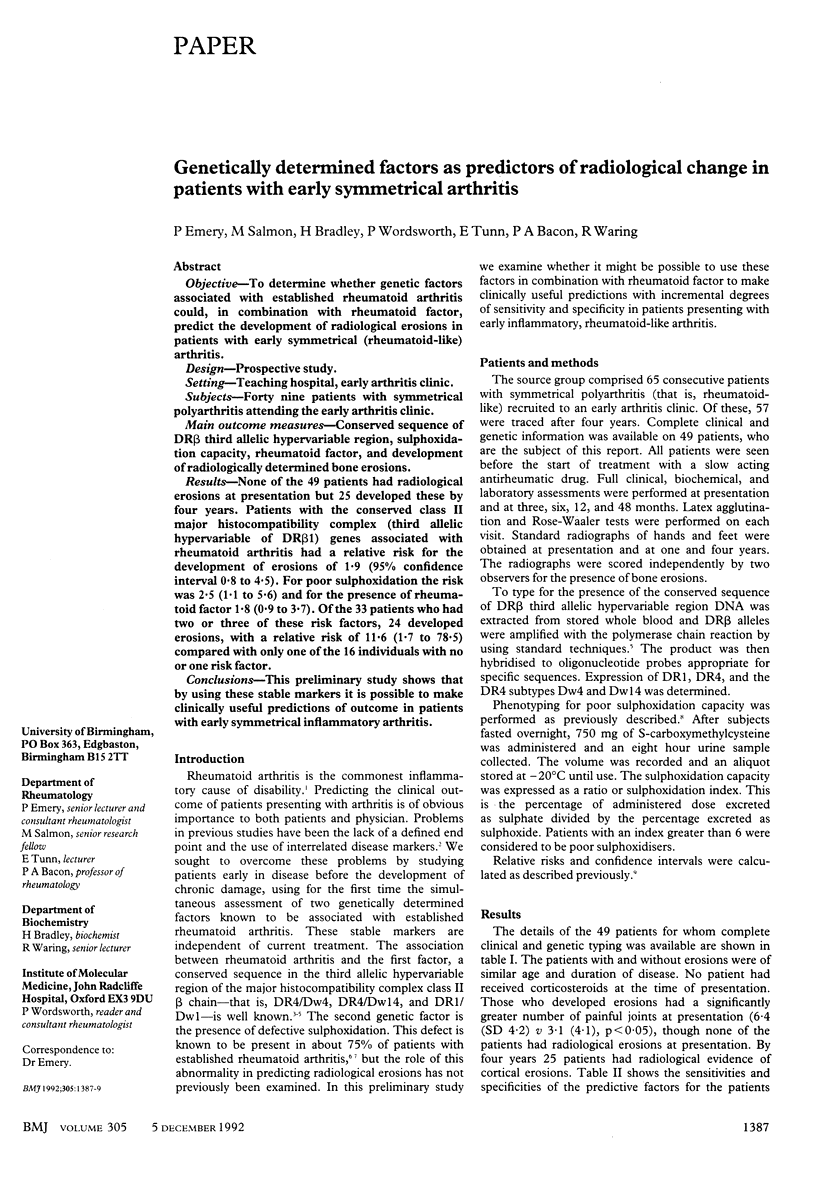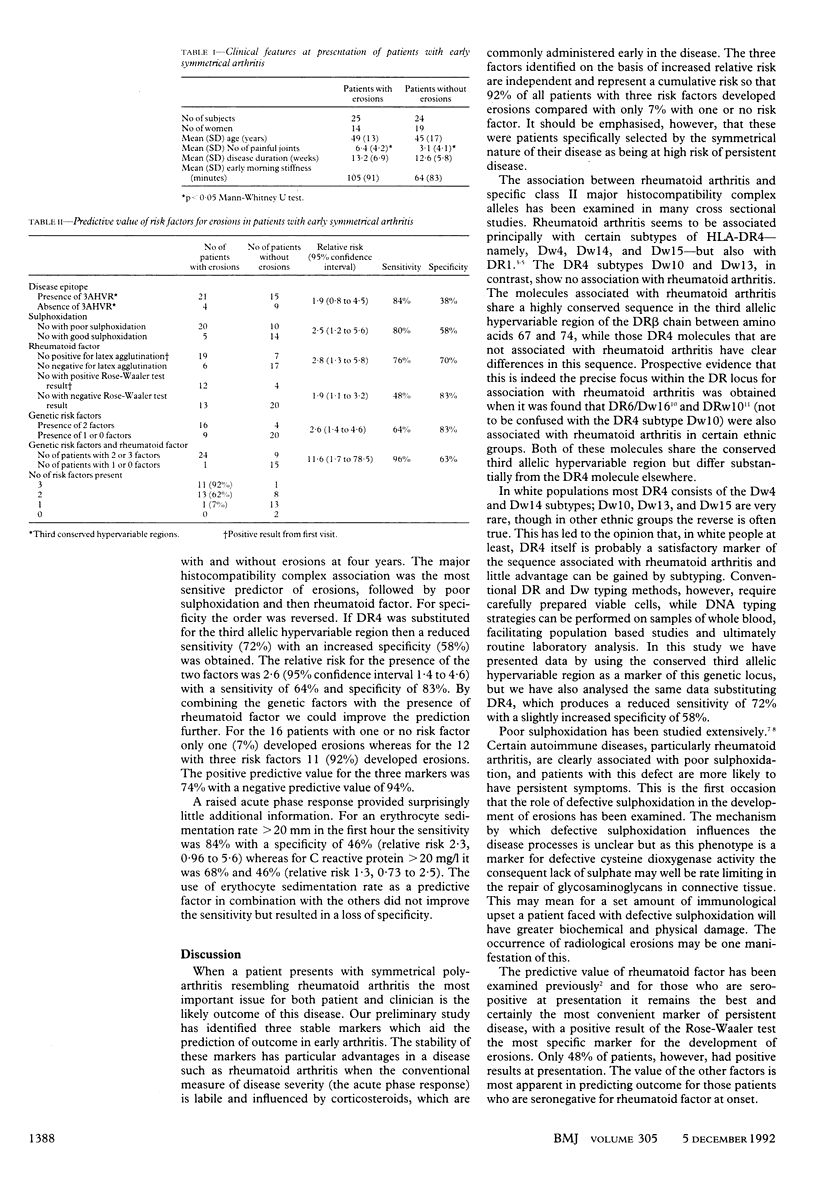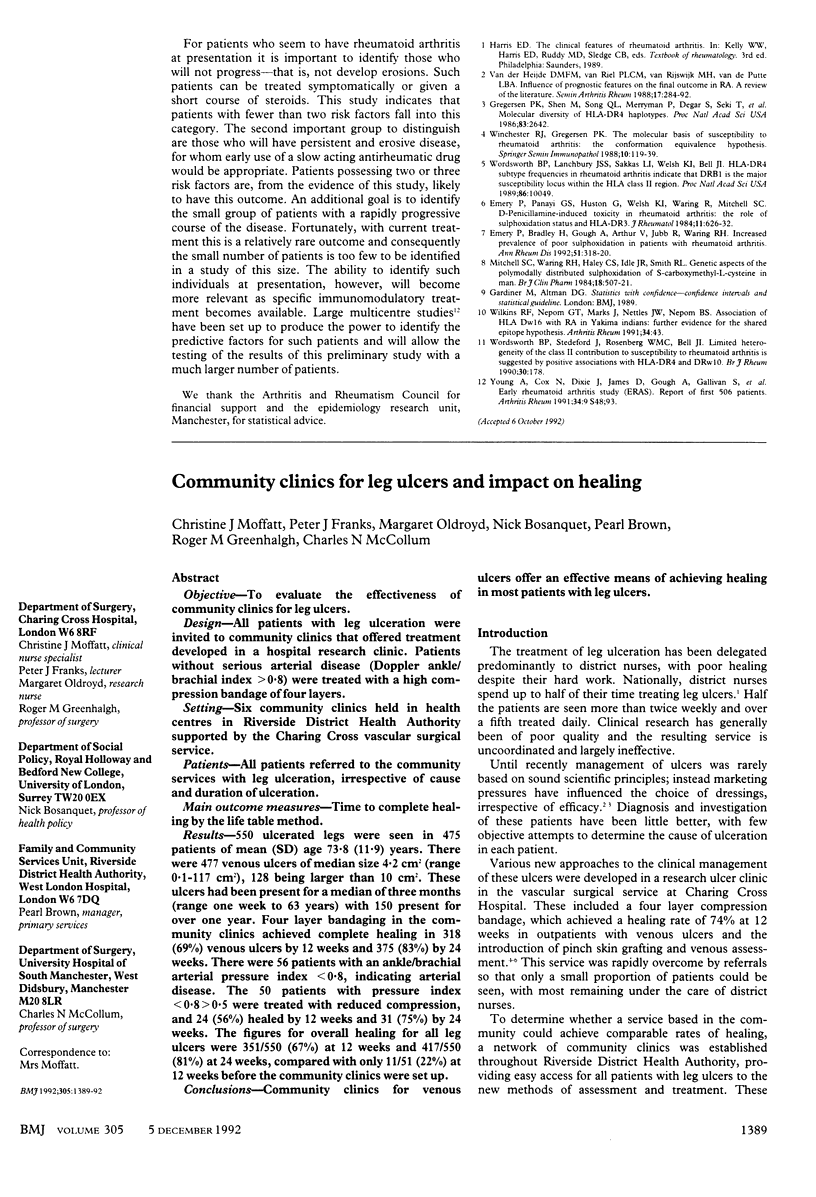Abstract
OBJECTIVE--To determine whether genetic factors associated with established rheumatoid arthritis could, in combination with rheumatoid factor, predict the development of radiological erosions in patients with early symmetrical (rheumatoid-like) arthritis. DESIGN--Prospective study. SETTING--Teaching hospital, early arthritis clinic. SUBJECTS--Forty nine patients with symmetrical polyarthritis attending the early arthritis clinic. MAIN OUTCOME MEASURES--Conserved sequence of DR beta third allelic hypervariable region, sulphoxidation capacity, rheumatoid factor, and development of radiologically determined bone erosions. RESULTS--None of the 49 patients had radiological erosions at presentation but 25 developed these by four years. Patients with the conserved class II major histocompatibility complex (third allelic hypervariable of DR beta 1) genes associated with rheumatoid arthritis had a relative risk for the development of erosions of 1.9 (95% confidence interval 0.8 to 4.5). For poor sulphoxidation the risk was 2.5 (1.1 to 5.6) and for the presence of rheumatoid factor 1.8 (0.9 to 3.7). Of the 33 patients who had two or three of these risk factors, 24 developed erosions, with a relative risk of 11.6 (1.7 to 78.5) compared with only one of the 16 individuals with no or one risk factor. CONCLUSIONS--This preliminary study shows that by using these stable markers it is possible to make clinically useful predictions of outcome in patients with early symmetrical inflammatory arthritis.
Full text
PDF


Selected References
These references are in PubMed. This may not be the complete list of references from this article.
- Emery P., Bradley H., Gough A., Arthur V., Jubb R., Waring R. Increased prevalence of poor sulphoxidation in patients with rheumatoid arthritis: effect of changes in the acute phase response and second line drug treatment. Ann Rheum Dis. 1992 Mar;51(3):318–320. doi: 10.1136/ard.51.3.318. [DOI] [PMC free article] [PubMed] [Google Scholar]
- Emery P., Panayi G. S., Huston G., Welsh K. I., Mitchell S. C., Shah R. R., Idle J. R., Smith R. L., Waring R. H. D-Penicillamine induced toxicity in rheumatoid arthritis: the role of sulphoxidation status and HLA-DR3. J Rheumatol. 1984 Oct;11(5):626–632. [PubMed] [Google Scholar]
- Gregersen P. K., Shen M., Song Q. L., Merryman P., Degar S., Seki T., Maccari J., Goldberg D., Murphy H., Schwenzer J. Molecular diversity of HLA-DR4 haplotypes. Proc Natl Acad Sci U S A. 1986 Apr;83(8):2642–2646. doi: 10.1073/pnas.83.8.2642. [DOI] [PMC free article] [PubMed] [Google Scholar]
- Mitchell S. C., Waring R. H., Haley C. S., Idle J. R., Smith R. L. Genetic aspects of the polymodally distributed sulphoxidation of S-carboxymethyl-L-cysteine in man. Br J Clin Pharmacol. 1984 Oct;18(4):507–521. doi: 10.1111/j.1365-2125.1984.tb02498.x. [DOI] [PMC free article] [PubMed] [Google Scholar]
- Willkens R. F., Nepom G. T., Marks C. R., Nettles J. W., Nepom B. S. Association of HLA-Dw16 with rheumatoid arthritis in Yakima Indians. Further evidence for the "shared epitope" hypothesis. Arthritis Rheum. 1991 Jan;34(1):43–47. doi: 10.1002/art.1780340107. [DOI] [PubMed] [Google Scholar]
- Winchester R. J., Gregersen P. K. The molecular basis of susceptibility to rheumatoid arthritis: the conformational equivalence hypothesis. Springer Semin Immunopathol. 1988;10(2-3):119–139. doi: 10.1007/BF01857219. [DOI] [PubMed] [Google Scholar]
- Wordsworth B. P., Lanchbury J. S., Sakkas L. I., Welsh K. I., Panayi G. S., Bell J. I. HLA-DR4 subtype frequencies in rheumatoid arthritis indicate that DRB1 is the major susceptibility locus within the HLA class II region. Proc Natl Acad Sci U S A. 1989 Dec;86(24):10049–10053. doi: 10.1073/pnas.86.24.10049. [DOI] [PMC free article] [PubMed] [Google Scholar]
- Wordsworth B. P., Stedeford J., Rosenberg W. M., Bell J. I. Limited heterogeneity of the HLA class II contribution to susceptibility to rheumatoid arthritis is suggested by positive associations with HLA-DR4, DR1 and DRw10. Br J Rheumatol. 1991 Jun;30(3):178–180. doi: 10.1093/rheumatology/30.3.178. [DOI] [PubMed] [Google Scholar]
- van der Heijde D. M., van Riel P. L., van Rijswijk M. H., van de Putte L. B. Influence of prognostic features on the final outcome in rheumatoid arthritis: a review of the literature. Semin Arthritis Rheum. 1988 May;17(4):284–292. doi: 10.1016/0049-0172(88)90013-3. [DOI] [PubMed] [Google Scholar]


